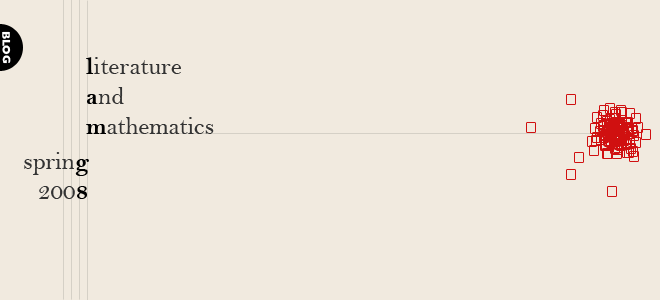One of the coolest parts of the movie to me was when they were talking about the Torah, so I looked into it a little more. This example that I'm about to give is definitely reaching a bit, but I thought it was pretty fun, so I'll share it.
Apparently, in Jewish tradition, there is a word that appears in portions of the Books of the Prophets that is occasionally read Kri, which is differently than it is written, Ktiv. So the mystery is that the numerical value for the written word is 111 while the numerical value for the way it is read is 106! Now, the ratio 111/106= 1.047169811. Doesn't mean anything yet right? Wait! Read this!
"A plain reading of 1 Kings 7:23 suggests that its author believed that 3, rather than 3.14159..., is the value of Pi. The verse describes the molten sea that was made in the Temple as being 10 cubits from brim to brim (diameter) and as being encircled completely by a line of 30 cubits (circumference)." (Wikipedia - of course)
So it still doesn't mean much... BUT... the ratio between Pi and 3 is approximately 1.047197551. So the conclusion is that 111/106 * 3 = 3.141509434 which is 99.997% of the known value! (obviously since it got the first 5 digits right and the rest are unimportant anyway...) So it is believed that they had a better approximation of Pi than we thought.
The study is called Gematria. There are different types of Gematria but they all consist in finding patterns between the 22 letters of the Hebrew alphabet and either mathematical objects or sentences from the Torah. For example, there are 22 solids made of regular polygons, so there should be some relationship there. It's pretty neat stuff...
Also, if you count the letters of this phrase "God is ever a geometer" (ἀεὶ ὁ Θεὸς ὁ μέγας γεωμετρεῖ) you will find the first six digits of pi!
| Decimal | Hebrew | Glyph |
|---|---|---|
| 1 | Aleph | א |
| 2 | Bet | ב |
| 3 | Gimel | ג |
| 4 | Daled | ד |
| 5 | He | ה |
| 6 | Waw | ו |
| 7 | Zayin | ז |
| 8 | Heth | ח |
| 9 | Teth | ט |
| 10 | Yodh | י |
| 20 | Kaph | כ, ך |
| 30 | Lamed | ל |
| 40 | Mem | מ, ם |
| 50 | Nun | נ, ן |
| 60 | Samekh | ס |
| 70 | Ayin | ע |
| 80 | Pe | פ, ף |
| 90 | Tsadi | צ, ץ |
| 100 | Qoph | ק |
| 200 | Resh | ר |
| 300 | Shin | ש |
| 400 | Taw | ת |
| 500 | Kaph | ך |
| 600 | Mem | ם |
| 700 | Nun | ן |
| 800 | Pe | ף |
| 900 | Tsadi | ץ |
So if anyone's bored... try to find patterns!

1 comment:
I must say that what you found is one of the coolest things that i have heard in a while, but not that suprising. Certain civilizations have shown architecture and art that depicts knowledge that we once thought impossible for them to know. One of the ancient Roman buildings for example has a domed roof, cool right. But what makes it really cool is that it is a perfect semi-sphere and the building is in fact made so that if the entire sphere were made then it would go down and touch at just one point at the very center of the floor. So why is it that suprising that the Jews new about pi when the Romans obviously knew about it.
Post a Comment